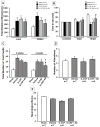Anti-neutrophil antibody enhances the neuroprotective effects of G-CSF by decreasing number of neutrophils in hypoxic ischemic neonatal rat model
- PMID: 24874543
- PMCID: PMC4109395
- DOI: 10.1016/j.nbd.2014.05.024
Anti-neutrophil antibody enhances the neuroprotective effects of G-CSF by decreasing number of neutrophils in hypoxic ischemic neonatal rat model
Abstract
Objectives: Neonatal hypoxia ischemia (HI) is an injury that can lead to neurological impairments such as behavioral and learning disabilities. Granulocyte-colony stimulating factor (G-CSF) has been demonstrated to be neuroprotective in ischemic stroke however it has also been shown to induce neutrophilia, ultimately exacerbating neuronal injury. Our hypothesis is that coadministration of anti-neutrophil antibody (Ab) with G-CSF will decrease blood neutrophil counts thereby reducing infarct volume and improving neurological function post HI brain injury.
Methods: Rat pups were subjected to unilateral carotid artery ligation followed by 2.5h of hypoxia. Animals were randomly assigned to five groups: Sham (n=15), vehicle (HI, n=15), HI with G-CSF treatment (n=15), HI with G-CSF+Ab treatment (n=15), and HI with Ab treatment (n=15). Ab (325μg/kg) was administered intraperitoneally while G-CSF (50μg/kg) was administered subcutaneously 1h post HI followed by daily injections for 3 consecutive days. Animals were euthanized at 96h post HI for blood neutrophil counts and brain infarct volume measurements as well as at 5weeks for neurological function testing and brain weight measurements. Lung and spleen weights at both time points were further analyzed.
Results: The G-CSF treatment group showed tendencies to reduce infarct volume and improve neurological function while significantly increasing neutrophil counts. On the other hand, the G-CSF+Ab group significantly reduced infarct volume, improved neurological function and decreased neutrophil counts. The Ab alone group showed reversal of the neuroprotective effects of the G-CSF+Ab group. No significant differences were found in peripheral organ weights between groups.
Conclusion: Our data suggest that coadministration of G-CSF with Ab not only prevented brain atrophy but also significantly improved neurological function by decreasing blood neutrophil counts. Hence the neuroprotective effects of G-CSF may be further enhanced if neutrophilia is avoided.
Keywords: Anti-neutrophil antibody (Ab); Granulocyte-colony stimulating factor (G-CSF); Hypoxia–ischemia (HI); Neonatal; Neurological function; Neutrophil.
Copyright © 2014 Elsevier Inc. All rights reserved.
Conflict of interest statement
The authors declare they have no conflict of interest.
Figures




References
-
- Barone FC, et al. Polymorphonuclear leukocyte infiltration into cerebral focal ischemic tissue: myeloperoxidase activity assay and histologic verification. J Neurosci Res. 1991;29(3):336–45. - PubMed
-
- Beck H, et al. Participation of bone marrow-derived cells in long-term repair processes after experimental stroke. J Cereb Blood Flow Metab. 2003;23(6):709–17. - PubMed
-
- Bracewell M, Marlow N. Patterns of motor disability in very preterm children. Ment Retard Dev Disabil Res Rev. 2002;8(4):241–8. - PubMed
-
- Broudy VC, et al. Human umbilical vein endothelial cells display high-affinity c-kit receptors and produce a soluble form of the c-kit receptor. Blood. 1994;83(8):2145–52. - PubMed
Publication types
MeSH terms
Substances
Grants and funding
LinkOut - more resources
Full Text Sources
Other Literature Sources

